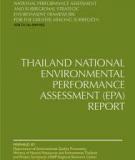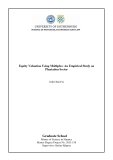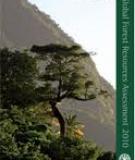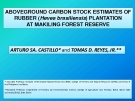
Hevea plantations
-
Natural rubber is currently produced nearly exclusively from latex of the Para rubber tree, Hevea brasiliensis. The desire to reduce the environmental cost of rubber production, fears of pathogen susceptibility in clonal Hevea plantations, volatility in the price of natural rubber.
 10p
10p  viharuno2711
viharuno2711
 24-04-2020
24-04-2020
 38
38
 0
0
 Download
Download
-
Corynespora leaf fall (CLF) disease of rubber incited by Corynespora cassiicola is listed as a fourth most serious leaf disease of rubber in South East Asia. As the rubber is a tree crop it grows up to 60 – 70 feet height, management of this disease is not easy and it involves more price tag. The use of effective and economical management strategies is plays a vital role in efficient disease management in rubber plantations. To develop a tool to integrated disease management approach, tested different bio-agents, plant extracts and fungicides against Corynespora cassiicola.
 8p
8p  cothumenhmong1
cothumenhmong1
 08-12-2019
08-12-2019
 11
11
 0
0
 Download
Download
-
Hevea brasiliensis, like many plants produces latex that oozes from injuries to the stem in the form of a milky sap. Latex is produced by special cells called laticifers and is thought to be a defence against insect pathogens and possibly a medium for depositing metabolic waste of the tree. Latex flows from the living parts of a rubber tree in response to wounding, tapping being in fact controlled wounding using the sap for the manufacture of rubber without seriously damaging the tree (Edgar, 1947).
 27p
27p  thieubaotrang
thieubaotrang
 23-04-2013
23-04-2013
 71
71
 2
2
 Download
Download
-
In Southeast Asia there have been found a lot of rubber-bearing plants. Most of them are members of the one family, Apocynaceae, but there are also some important species from other families, like Ficus elastica Roxb. and Bleekrodea tonkinensis Dub. & Eber., which both belongs to the family Moraceae. The first seeds for the cultivation of the rubber were sent to Asia, Sri Lanka, in 1876, but these first attempts to grow the rubber trees (Hevea brasiliensis Muell. Arg.) were not successful. It was not until 1877 when 22 rubber trees were plated in Singapore. From...
 121p
121p  thieubaotrang
thieubaotrang
 23-04-2013
23-04-2013
 65
65
 6
6
 Download
Download
-
Natural rubber is produced by Hevea brasiliensis, a tree native to the Amazon region of South America. In the late eighteenth century, rubber was introduced to the Far East, which is now the main rubber-producing region of the world. Currently, the major producers of natural rubber are Thailand, Indonesia, Malaysia, India, China, Viet Nam and Sri Lanka. In 2005, the world’s production of natural rubber amounted to 8 682 million tonnes whereby 7 466 million tonnes (approximately 86 percent) originated from these seven countries.
 0p
0p  thieubaotrang
thieubaotrang
 23-04-2013
23-04-2013
 43
43
 3
3
 Download
Download
-
The Pest Risk Analysis on South American Leaf Blight, The Contingency Plan for South American Leaf Blight of Rubber and the Model Work Plan for the Importation of Budded Stumps or Budwood of Hevea are supporting documents for the implementation of the Regional Standards for Phytosanitary Measures No. 7 – Guidelines for Protection against South American Leaf Blight of Rubber. These documents reflect the most up-to-date progress of APPPC in terms of management of SALB and are essential references for protection against SALB in Asia and Pacific region.
 0p
0p  thieubaotrang
thieubaotrang
 23-04-2013
23-04-2013
 74
74
 3
3
 Download
Download
-
Subsistence agriculture to produce cassava, plantains, cocoyams, yams, maize, ground- nuts, etc, mainly for home consumption, is the main activity on the plain. Small quantities of cocoa (for sale) and coffee (mainly for home consumption) are produced. There are smallholder cooperative associations at lloani and Mbongo villages which pro- duce palm oil , from two small Stork mills of 5t FFB per day capacity. The oi l is sold on the local market through the Catholic Mission at Mbonge. Members earn about 110 000 CFAF a year from palm oil .
 0p
0p  thieubaotrang
thieubaotrang
 23-04-2013
23-04-2013
 50
50
 3
3
 Download
Download
-
The young alluvial soils show little profile development although they are sometimes stratified. With the exception of about 800 ha of sand to loamy sand soils in one area, textures vary from sandy loam to uniform clay, with the finer textures tending to occur toward the mangrove and in the flood-prone area between the Meme and Mokoko Rivers. Although there is evidence of flooding and seasonal waterlogging from several other rivers that traverse the plain, these soils rarely show evidence of strongly reducing conditions within 1.5 m of the surface.
 30p
30p  thieubaotrang
thieubaotrang
 23-04-2013
23-04-2013
 41
41
 2
2
 Download
Download
CHỦ ĐỀ BẠN MUỐN TÌM








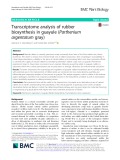
![Evaluation of different fungi toxicants against Corynespora Cassiicola causing corynespora leaf fall (CLF) disease of rubber [Hevea brasiliensis Muell. Arg.,] Evaluation of different fungi toxicants against Corynespora Cassiicola causing corynespora leaf fall (CLF) disease of rubber [Hevea brasiliensis Muell. Arg.,]](https://tailieu.vn/image/document/thumbnail/2019/20191208/cothumenhmong1/135x160/451575821464.jpg)
